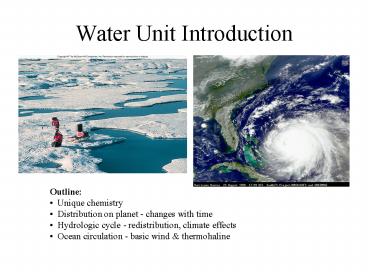Water Unit Introduction - PowerPoint PPT Presentation
1 / 23
Title:
Water Unit Introduction
Description:
Water Unit Introduction Outline: Unique chemistry Distribution on planet - changes with time Hydrologic cycle - redistribution, climate effects Ocean circulation ... – PowerPoint PPT presentation
Number of Views:135
Avg rating:3.0/5.0
Title: Water Unit Introduction
1
Water Unit Introduction
- Outline
- Unique chemistry
- Distribution on planet - changes with time
- Hydrologic cycle - redistribution, climate
effects - Ocean circulation - basic wind thermohaline
2
- Chemically unique because it
- exists in all three phases at atmospheric temp
pressure (high melting and boiling points for
size bond type- ammonia-NH3-mass 17, MP -78, BP
33) and is the only substance that does this! - has covalent bonds for molecule, hydrogen bonds
for liquid/solid phase (10x stronger than usual
inter-molecular bonds, but weaker than metal or
ionic bond)
3
- Chemically and physically unique because it has
- high heat capacity - 4.2 J/g/K- i.e., takes more
energy to raise temp, therefore stores more,
important for spreading planets heat - high heat of fusion (solid ltgt liquid 335
J/g/ºK) and vaporization (liquid ltgtgas 2400
J/g/ºK) so more effectively transfers heat when
changing phase in atmosphere/ocean - conducts heat more readily as a liquid
4
- Water is chemically and biologically unique
because it - has high surface tension so forms drops helps
make good cell membranes - can dissolve other compounds very easily (most
common solute), so can transport many things,
e.g. NaCl, nutrients - mediates or facilitates most chemical reactions
in living systems (e.g., takes water to
photosynthesize) - neutral pH
5
Water is physically unique because it is less
dense as a solid (ice) than as a liquid.
6
(No Transcript)
7
Distribution on Earth Water, water everywhere,
nor any drop to drink. Coleridge, Rime of the
Ancient Mariner
8
Hydrologic Cycle (in 103 km3)
9
(No Transcript)
10
(No Transcript)
11
(No Transcript)
12
(No Transcript)
13
Effects of global warming on water cycle
Global warming (temperature increase)
Speeds up global water cycle
- More extreme weather events
- Droughts
- Storms
- Floods
14
Projected Changes in Annual Precipitation for the
2050s
The projected change is compared to the present
day with a 1 increase per year in equivalent CO2
Source The Met Office. Hadley Center for Climate
Prediction and Research
15
Global Precipitation Trends ( per decade) 1900
- 1994
Green increasing, Brown decreasing
Source Watson 2001
16
U.S. Precipitation Trends 1901 to 1998
Green increasing, Brown decreasing All
stations/trends displayed regardless of
statistical significance
Source National Climatic Data Center/NESDIS/NOAA
17
Extreme Precipitation Events in the U.S.
Source Karl, et.al. 1996.
18
(No Transcript)
19
(No Transcript)
20
(No Transcript)
21
(No Transcript)
22
(No Transcript)
23
(No Transcript)































